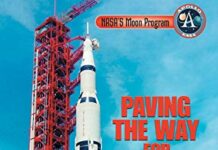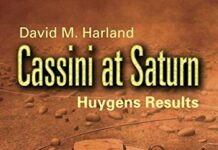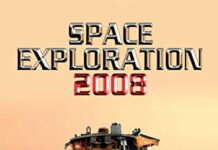
Ebook Info
- Published: 2008
- Number of pages: 400 pages
- Format: PDF
- File Size: 48.61 MB
- Authors: David M. Harland
Description
In this comprehensive overview of Man’s relationship with his planet’s nearest neighbor, David Harland opens with a review of the robotic probes, namely the Rangers which returned television before crashing into the Moon, the Surveyors which ‘soft landed’ in order to investigate the nature of the surface, and the Lunar Orbiters which mapped prospective Apollo landing sites. He then outlines the historic landing by Apollo 11 and the final three missions of comprehensive geological investigations. He concludes with a review of the robotic spacecraft that made remote-sensing observations of the Moon. This Commemorative Edition includes a foreword by one of the original astronauts as well as an extra section reviewing the prospect of renewed exploration there. New graphics and images are also included.
User’s Reviews
Editorial Reviews: Review From the reviews of the first edition -“A detailed guide to what the astronauts did during their stays on the lunar surface. Walk(s) the reader through the prospecting excursions and then incorporate(s) decades of subsequent analysis to put the explorations of dust, rocks, craters, and rilles into geologic context.” SKY & TELESCOPE”EXPLORING THE MOON is very well illustrated…All aficionados of the Apollo program will find much to appreciate in [this book].”…this is an interesting account of one of the most extraordinary decades in history…a very different book. David Harland probably knows more about the nuts and bolts of the Russian and American space programs than any other author and it shows.”LUNAR & PLANETARY INFORMATION BULLETINFrom the reviews of the second edition:”David Harland’s book is an honourable addition to the ranks. Exploring the Moon – The Apollo Expeditions is packed with photos, and features a historically detailed text backed by a thorough index. … If you want to know the exact order in which NASA’s Apollo astronauts surveyed particular zones of their landing sites, or which craters delivered the most interesting scientific clues about the origins of the Moon, then this is the book for you. … a fantastic resource for fans of the Apollo era.” (Piers Bizony, BBC Sky at Night, July, 2008)”A wealth of knowledge regarding the early days of manned space exploration. … Its high resolution photography brings a surface that few have seen before into crystal clarity.” (James M. Busby, Space Times, Vol. 47 (3), 2008) From the Back Cover David Harland opens with a review of the robotic probes, namely the Rangers which returned television before crashing into the Moon, the Surveyors which ‘soft landed’ in order to investigate the nature of the surface, and the Lunar Orbiters which mapped prospective Apollo landing sites. He then outlines the historic landing by Apollo 11 in terms of what was discovered, and how over the next several missions the program was progressively geared up to enable the final three missions each to spend three days on comprehensive geological investigations. He concludes with a review of the robotic spacecraft that made remote-sensing observations of the Moon. Although aimed at the enthusiast, and can be read as an adventure in exploration, the book develops the scientific theme of lunar geology, and therefore will be of use as background reading for undergraduate students of planetary sciences. In addition, with the prospect of a resumption of human missions, it will help journalists understand what Apollo achieved after the ‘flags and footprints’ of the Apollo 11 landing in July1969 and will commemorate the fortieth anniversary of that momentous event.Highlighted as a “Commemorative Edition” on the cover, this second edition has a new foreword by one of the original astronauts and a short extra section at the end previewing the prospect of a renewal of human exploration of the Moon. It will include new extra high quality graphics which are only now available and 32 pages of colour illustrations. From the reviews of the first edition -“A detailed guide to what the astronauts did during their stays on the lunar surface. Walk(s) the reader through the prospecting excursions and then incorporate(s) decades of subsequent analysis to put the explorations of dust, rocks, craters, and rilles into geologic context.” SKY & TELESCOPE”EXPLORING THE MOON is very well illustrated…All aficionados of the Apollo program will find much to appreciate in [this book].”…this is an interesting account of one of the most extraordinary decades in history…a very different book. David Harland probably knows more about the nuts and bolts of the Russian and American space programs than any other author and it shows.”LUNAR & PLANETARY INFORMATION BULLETIN
Reviews from Amazon users which were colected at the time this book was published on the website:
⭐Exploring the Moon’takes you on a unique scientific journey as told through the men who first(and possibly the only ones ever)left their footprints on the Moon’s surface.This book is not for the casual reader,but rather a detailed geological history of it’s rock morphology and surface features.Each Apollo mission carries a narrative of hour by hour decisions,discoveries,and analyses of both NASA ground officials and each Apollo lunar astronauts.The text is a well written series of chronological events with a heavy emphasis on the geological study of the lunar landscape.The massive inclusion of official NASA photos of each mission(most taken by the Apollo crew members during the missions)is a historical treasure trove by itself!WOW!As an avid student of all things geology,I recommend this edition to anyone interested in space exploration and our closest celestial neighbor.We have liftoff
⭐”Exploring the Moon” is a detailed review of the moon walks, especially (nearly 3/4 of the book) of the “J” missions of Apollo 15, 16, and 17. The book has detailed descriptions of the roving on the moon, the work done there and a fair amount about the geological discoveries. For those who spent hours glued to the TV watching these treks of discovery, this book takes you back and gives you new insights. The book also has hundreds of photos from the moon walks, although they are reproduced as tiny images. About the only criticism that I have is that the images are way too small and the book is available only in paperback. One hopes that a large format hardcover edition of this will be released, showing the photos in their full glory. For anybody interested in the actual moonwalks, this is the book to buy!
⭐David Harland wrote an informative and exciting book that covers the most neglected aspect of the Apollo missions: field geology! The reason men were sent to the Moon was to understand how the Moon formed and what it was like. I’ve only flipped through this book for about 5 minutes and I can’t take my eyes away! The STUNNING illustrations and vivid details of the astronaut’s activities and discoveries are breathtaking! This is an essential addition to any Apollo obsessed fanatic’s library!
⭐Wouldn’t let me give 3 & 1/2 stars.A great book if you want a lot of technical information on moon rocks.While there are some good pics they are 99% black & white.It does give some excellent backstories on the moonwalkers,but somehow falls short. I read this after reading Spaceshots & Snapshots of Projects Mercury & Gemini and Exploring does not come close to this fine book.
⭐This is the only book you need about the Apollo missions. It explains where and why certain areas were picked. The different missions and materials used. This is it. Read it. Read it again, and use it for reference.
⭐In the last decade no one has been more productive than British writer David M. Harland at turning out histories of spaceflight written for a popular audience. All have similar features, a mastery of the secondary literature, especially that available through the NASA History Series, a digestion of a wealth of scientific and technical information, and an engaging writing style that focuses on narrative rather than analysis. “Exploring the Moon: The Apollo Expeditions” is very much in sync with Harland’s earlier works and serves as a useful introduction to the subject. Not a scholarly work–there are no footnotes–but it does have an extensive bibliography. His emphasis in this book is on the work of the six crews of astronauts that landed on the Moon, although there is an opening chapter on the robotic precursors and concluding chapters on Apollo in context and exploration of the Moon in the 1990s.The heart of this book are the six chapters dealing with the lunar surface activities of Apollo 11, 12, 14, 15, 16, and 17. Harland expends the majority of the books space on the last three of this, and appropriately so because they represented the most significant scientific return of the program. NASA took a building block approach to exploration, something that seems obviously rational now but was not so well accepted at the time, with time on the surface and complexity of the mission advancing with every flight. The last three missions, of course, were extraordinary in collecting superb scientific data about the Moon, its origins, and the evolution of the solar system. Collectively, experiments carried out as a result of Apollo yielded more than 10,000 scientific papers and a major reinterpretation of the origins and evolution of the Moon.”Exploring the Moon: The Apollo Expeditions” is a solid discussion, if uninspired history of lunar surface activity. Readers should read it in conjunction with two other major sources. The first is NASA’s official history of the Apollo lunar surface activities entitled “Where No Man Has Gone Before: A History of Apollo Lunar Exploration Missions,” by W. David Compton (Washington, DC: National Aeronautics and Space Administration SP-4214, 1989). Is conveniently available on-line for those who do not need a physical copy at […] Second, anyone who hopes to understand these missions must read the “Apollo Lunar Surface Journal,” the brainchild of Eric Jones. Jones has placed on-line more detailed information about the astronauts on the lunar surface than anyone previously. This is available for all to review at […]
⭐Having worked on the Apollo launches at Kennedy, I was most interested in reading this book, as most of my interest to date has been with the history of the space program, not lunar geology which I admit I knew nothing about.Mr. Harland does a very good job in bringing the surface explorations to life, and if I didn’t know better, I would have thought he was a third astronaut taking notes while the other 2 went about their tasks. It is that detailed, yet still fascinating to read.He has also done an excellent job in reproducing the photos. The quality is better than I have ever seen. He even went to great pains to remove all the crosshairs. A previous reviewer complained about the small photos, but the 40th Anniversary Edition is chock full of full page photos, many in color.Also included are specs of all the manned missions and descriptions of all the other unmanned recon missions that went before.If you want details of the entire missions, look elsewhere, but if you want to know what happened after touchdown, this is the book.
⭐I bought this book – I though to myself – which book to buy to have all the missions in one book – and one book was obvious – again Harland made the book for me – fantastic. Detailed chapters on each mission – not too detailed but detailed enough – with lots of photographs – to get your knowledge-level up to standard about these fantastic trips to the moon. The mission got more and more progressive and I have always liked the Apollo 17 mission the most – Maybe because this was the “real” geology-mission. I have always though that the geology was the interesting part of getting to a place which looks desolate and barren. But the moon turned out to be an interesting place – when you have read the last mission-chapter – you will know why.Thouroughly recommended for expanding your level of knowledge about the Apollo mission and the Moon.
⭐A a wonderful book about what the astronauts actually did on the surface of the moon. Each mission being longer and more complex. A great addition to your NASA library
⭐Simplemente , en mi modesta opinión , ESPECTACULAR E IMPRESCINDIBLE , puesto preferente en mi biblioteca de astronáutica. 100% recomendable
⭐Not found.
⭐Superb. The book arrived within few days, well before the delay of delivery and was carefully wrapped with a layer of plastic and the cardboard box in which it arrived. The book itself is amazing for those who “breath” Apollo missions. One of the best purchases I have done. Thanks
⭐Un must pour tous les amateurs de la conquête spatiale et en particulier des missions apollo. Les photos sont simplement superbes. Un bouquin agréable à feuilleter
⭐Not found.
Keywords
Free Download Exploring the Moon: The Apollo Expeditions (Springer Praxis Books / Space Exploration) 2nd Edition in PDF format
Exploring the Moon: The Apollo Expeditions (Springer Praxis Books / Space Exploration) 2nd Edition PDF Free Download
Download Exploring the Moon: The Apollo Expeditions (Springer Praxis Books / Space Exploration) 2nd Edition 2008 PDF Free
Exploring the Moon: The Apollo Expeditions (Springer Praxis Books / Space Exploration) 2nd Edition 2008 PDF Free Download
Download Exploring the Moon: The Apollo Expeditions (Springer Praxis Books / Space Exploration) 2nd Edition PDF
Free Download Ebook Exploring the Moon: The Apollo Expeditions (Springer Praxis Books / Space Exploration) 2nd Edition





